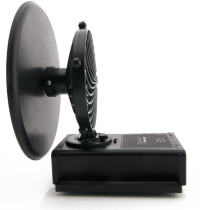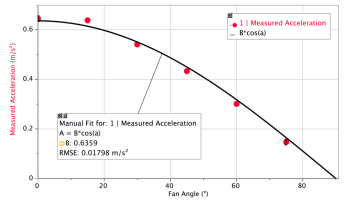Encoder Fan Cart User Manual
Order Code: CART-FEC
The Encoder Fan Cart is an encoder dynamics cart equipped with a built-in three-speed fan. The mass of the cart can be changed with the included masses, and the fan can be rotated to change the direction of the thrust. The cart is used to perform experiments regarding constant acceleration and Newton’s second law. The encoder portion of the cart is for use with the Vernier Dynamics Cart and Track System, order code DTS-EC. The Encoder Fan Cart can also be used with a Motion Detector, but the encoder function will not operate.
The Fan Cart is compatible with the track found in the Dynamics Cart and Track System, which can also be purchased separately, in either the 1.2 or 2.2 m lengths.
The Fan Cart operates on four AA batteries, not included. The encoder portion of the cart requires an additional two AAA batteries. Either conventional primary cells or rechargeable NiMH batteries can be used.
A sail, included with the Fan Cart, can be attached to perform the fan-on-a-sailboat experiment.
Refer to the instructions included with the Dynamics Cart and Track System with Motion Encoder for details on the use of the encoder portion of this fan cart. The Dynamics Cart and Track System with Motion Encoder user manual can be found at www.vernier.com/dts-ec
Note: Vernier products are designed for educational use. Our products are not designed nor are they recommended for any industrial, medical, or commercial process such as life support, patient diagnosis, control of a manufacturing process, or industrial testing of any kind.
What's Included
- Fan Cart
- Sail
- Hexagonal Mass Bars (2)
Using the Product
Setup
The Fan Cart is ready to use after inserting all six batteries.
- Set the fan angle as desired.
- Place the cart on the track with the encoder transmitter facing the receiver.
- Add zero, one, or two mass rods to select the desired mass.
- Turn on the encoder transmitter by pressing the power switch on the end cap.
- Turn on the fan using the slide switch, setting it to the desired speed.
- Release and capture the fan.
Suggestions
These suggestions will help you perform useful experiments while protecting the fan from damage.
- While the fan is rugged, it is not indestructible. Never allow it to fall to the floor.
- At higher thrusts, the cart can accelerate to a high speed. Be prepared to catch it gently before it strikes a wall, a track end stop, or a detector.
- Until you are familiar with the fan’s motion, have a second person start data collection while you launch and capture the cart.
Range Setting of the Encoder Fan Cart
The IR transmitter on the cart has two power levels available. The default 1 m setting conserves battery power. If the cart is used on a 2.2 m track, set the cart to the higher 2 m power level. If this setting is not used, the receiver will not reliably sense the position of the cart at the far end of the track. The switch is located inside the battery compartment.
Specifications
|
Mass of Encoder Fan Cart, typical batteries |
575 g |
|
Mass of Hexagonal Mass Bars |
215 g (may vary) |
|
Typical maximum acceleration |
0.6 m/s2 |
Fan Sail
The Fan Cart includes a sail. The sail, a dished black disc with a hole in the center, is attached using the 1/4-20 screw at the backside of the fan. We suggest that you store the screw in place. To attach the sail, remove the screw, attach the sail, and replace the screw.

|
The reality is complicated by the fact that the air movement is not stopped, but deflected. The air that moves away from the axis of the fan will not move the cart one way or another, but any air that leaks past the sail will accelerate the cart in the usual direction, while air that is diverted backward will accelerate the cart in reverse.
The sail is used to experimentally answer the question “Would a fan, mounted on the boat, make a sailboat move?” You will want to have students predict what will happen before performing the experiment. Some will expect the cart to be motionless, others will predict that the direction of acceleration is unchanged. Still others will predict a reversed acceleration, completing the possibilities.
The reality is complicated by the fact that the air movement is not stopped, but deflected. The air that moves away from the axis of the fan will not move the cart one way or another, but any air that leaks past the sail will accelerate the cart in the usual direction, while air that is diverted backward will accelerate the cart in reverse.
Try the sail in both orientations. If the sail were shaped to divert more of the air backward, the cart would accelerate at a higher rate in reverse. This is the principle used in reverse thrusters on passenger jets to slow the plane on landing.
Suggested Experiments
Kinematics of Constant Acceleration
Before considering Newton’s second law, students will want to observe motion graphs arising from constant acceleration.
The resulting position vs. time graph is parabolic. A quadratic equation can be used to fit the freely-rolling portion of the graph, when the fan is the only horizontal force on the cart. The resulting velocity vs. time graph is linear, with a slope corresponding to the acceleration. The resulting acceleration vs. time graph is nearly constant.
Newton’s Second Law
In each case, measure the acceleration of the cart on a level track. The slope of the velocity vs. time graph gives the best data for this purpose.
The acceleration can be measured as a function of
- Thrust, or fan speed
- Cart mass
- Angle of fan with respect to the direction of travel
In each case, the observed acceleration will be proportional to the force parallel to motion and inversely proportional to mass.
The thrust of the fan can be measured directly by allowing the fan cart to press against a force sensor. Attach or hold a force sensor on the track and turn on the fan so that the cart presses against the force sensor. Compare this reading to the force inferred from the cart mass and acceleration.
For the angled-fan experiment, the thrust is proportional to the cosine of the angle away from the motion. Using the highest thrust, we obtained Graph 1.

Warranty
Warranty information for this product can be found on the Support tab at www.vernier.com/cart-fec/#support
General warranty information can be found at www.vernier.com/warranty
Contact Support
Fill out our online support form or call us toll-free at 1-888-837-6437.

